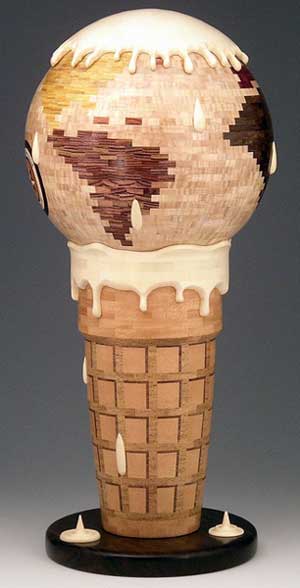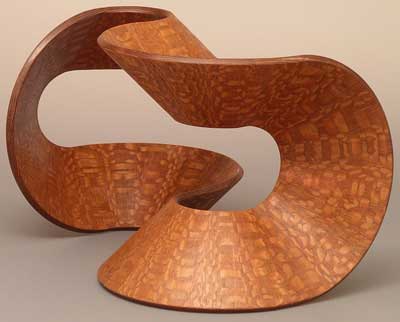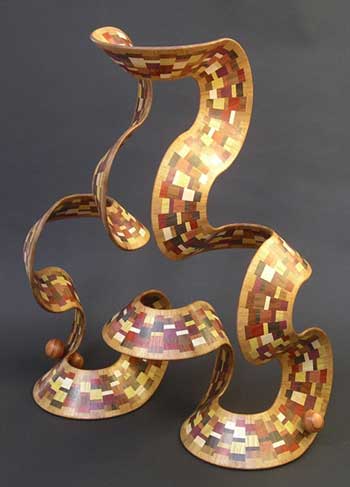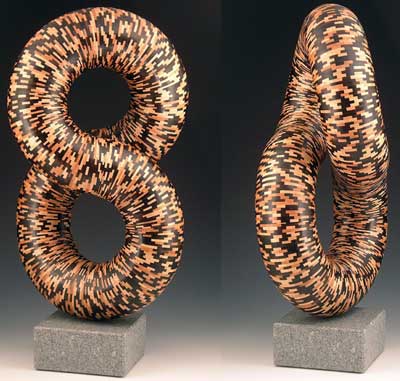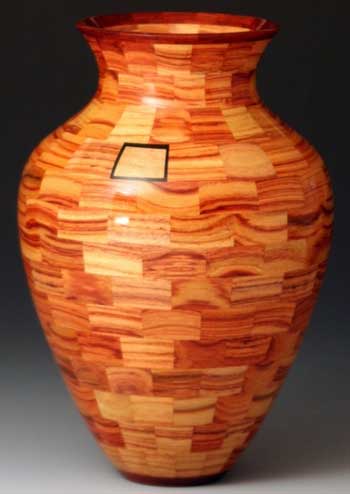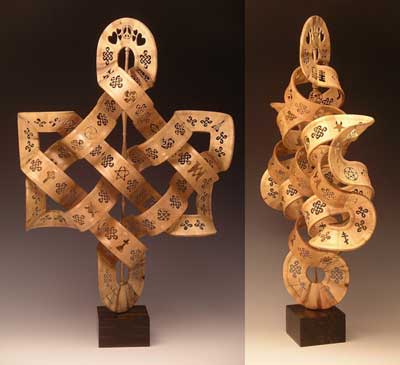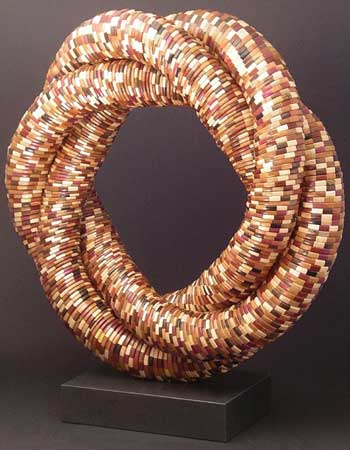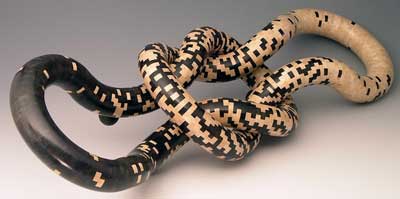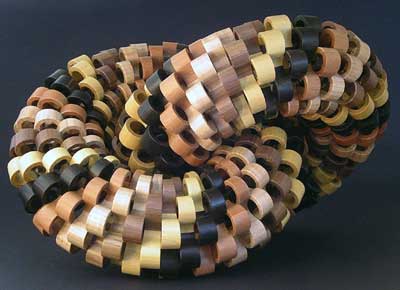
Right now, the first piece of woodworking you find in the gallery on Malcolm Tibbetts’s website is called “Smile on Your Brother.” It’s composed of two 13” diameter donut shapes, each constructed from 50 ribbon rings. Each of those rings, in turn, is made from stave-constructed cylinders that have been turned, cut apart and reassembled in the proper dimensions for the piece: an example of Malcolm’s specialty, segmented woodturning.
It’s a method of woodturning that incorporates other woodworking techniques – and that, Malcolm says, is part of the appeal. Segmented woodturners, he said, are “usually woodworkers who started woodturning and, once they learned how to turn wood, they fall back on the skills they developed as woodworkers. Myself, I rarely turn a solid block of wood like a bowl.”
Instead, he’s a studio artist specializing in segmented woodturning – or, at least, he has been for about the last eight years. Before that, he spent 32 years working in the ski industry, with woodworking as a hobby on the side. It was a hobby that started soon after he married, when he bought a cheap table saw and began making furniture for the house he and his wife had just purchased. “It’s a not uncommon story,” he noted.
Years later, when they didn’t need any more furniture, he started playing around with the lathe. Malcolm’s opinion is that, “Getting into segmented woodturning was a natural progression, because I had the tools.”
Those tools include a table saw, chop saw and disc sander. “With the premise of segmented woodturning, a table saw and disc sander are the minimum required,” he said. “Some people use jigs and sleds on a table saw, but I use a chop saw.” They’re used for cutting wood to the correct sizes for the glued-up laminations he creates for his pieces, turns on the lathe, then cuts apart and reassembles into a variety of shapes, usually held together solely with glue, although he does sometimes use tiny dowels – aka, toothpicks – as well.
Malcolm’s shapes sometimes include segmented turning techniques he’s invented, such as the “ribbons” created from bottomless half-bowls. That’s something he developed during the latter portion of the time spent working on his book, The Art of Segmented Wood Turning. “To have contributed something like that to the field, is something to be proud of,” Malcolm said.
Since his foray into segmented woodturning as a serious hobby around 1992, when he began winning contests and so forth, Malcolm has also contributed how-to DVDs on the subject, founded an online chapter of the American Association of Woodturners dedicated solely to segmented woodturning, and is in the process of planning a November 2010 symposium on segmented woodturning to be held at Arrowmont School of Arts and Crafts in Gatlinburg, Tennessee. (Details will be posted soon on http://segmentedwoodturners.org/.)
“It’s a unique art form, requiring the use of both sides of the brain. You have to have the ability to visualize and perceive as a concept, and you also have to have the technical knowledge of woodworking equipment, how to cut and assemble things. You can only accept perfect joinery. It’s a challenge.”
When it comes to the woods used in these design challenges, Malcolm has to balance structural considerations against aesthetics. Very dry woods give his pieces stability – mesquite, he says, is the ideal wood for segmented turning because of its stability when dry – but he also needs to make choices based on color contrasts, and to make sure those colors stay contrasting over time: for example, over time, bloodwood and purpleheart placed next to each other would come to look the same.
One of his pieces, “Seggy’s Dream” tells the tale of these color placement choices through the dreams of a small segment of pink ivory that has been longing to be incorporated into a turning. Malcolm’s first video documented this wood segment’s dream, its perseverance – and the construction of the vessel it goes into. The vessel itself was auctioned on eBay as a fundraiser for the American Cancer Society.
“I enjoy creating work that has social meanings, that’s more than just a pretty bowl,” Malcolm said. As other favorites among his work, he cited “Tolerance,” a piece shaped like an endless knot displaying numerous cultural and religious symbols; “Gift of Gordius,” a 33” diameter Gordian knot made from 9,900 individual pieces of wood with many plays off the number 3 and its multiples in its construction; and “Martin’s Dream,” made from ebony and bird’s-eye maple and inspired by Martin Luther King Jr.’s “I Have a Dream” speech.
“The pieces I do that have some kind of story or, better yet, social justice message are the pieces I enjoy most,” Malcolm said. “I’m not a political junkie, but I pay attention to politics. I’m not a radical environmentalist, but I pay attention to it. My belief is that people in general are apathetic and need to express their beliefs more than they do. It’s my little contribution to change people’s views on things.”
